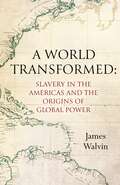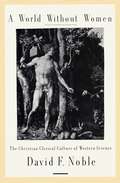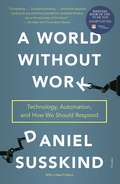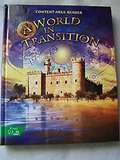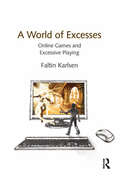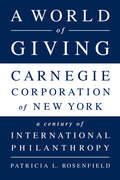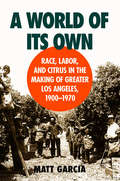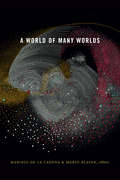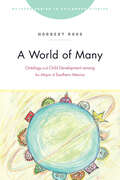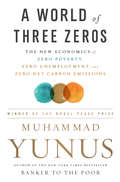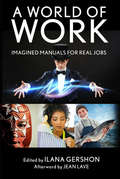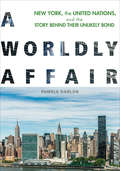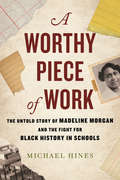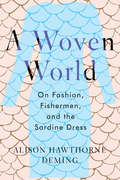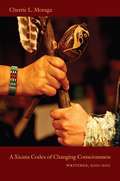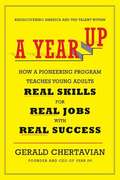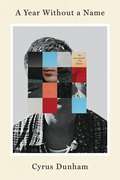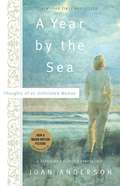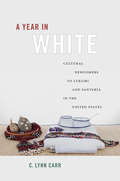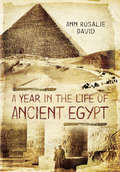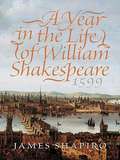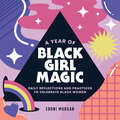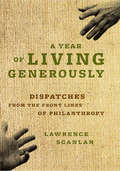- Table View
- List View
A World Transformed: Slavery in the Americas and the Origins of Global Power
by Professor James WalvinA World Transformed explores how slavery thrived at the heart of the entire Western world for more than three centuries. Arguing that slavery can only be fully understood by stepping back from traditional national histories, this book collects the scattered accounts of the most recent scholarship into a comprehensive history of slavery and its shaping of the world we know. Celebrated historian James Walvin tells a global story that covers everything from the capitalist economy, labor, and the environment, to social culture and ideas of family, beauty and taste.This book underscores just how thoroughly slavery is responsible for the making of the modern world. The enforced transportation and labour of millions of Africans became a massive social and economic force, catalysing the rapid development of multiple new and enormous trading systems with profound global consequences. The labour and products of enslaved people changed the consumption habits of millions - in India and Asia, Europe and Africa, in colonised and Indigenous American societies. Across time, slavery shaped many of the dominant features of Western taste: items and habits or rare and costly luxuries, some of which might seem, at first glance, utterly removed from the horrific reality of slavery. A World Transformed traces the global impacts of slavery over centuries, far beyond legal or historical endpoints, confirming that the world created by slave labour lives on today.
A World Transformed: Slavery in the Americas and the Origins of Global Power
by Professor James WalvinA World Transformed explores how slavery thrived at the heart of the entire Western world for more than three centuries. Arguing that slavery can only be fully understood by stepping back from traditional national histories, this book collects the scattered accounts of the most recent scholarship into a comprehensive history of slavery and its shaping of the world we know. Celebrated historian James Walvin tells a global story that covers everything from the capitalist economy, labor, and the environment, to social culture and ideas of family, beauty and taste.This book underscores just how thoroughly slavery is responsible for the making of the modern world. The enforced transportation and labour of millions of Africans became a massive social and economic force, catalysing the rapid development of multiple new and enormous trading systems with profound global consequences. The labour and products of enslaved people changed the consumption habits of millions - in India and Asia, Europe and Africa, in colonised and Indigenous American societies. Across time, slavery shaped many of the dominant features of Western taste: items and habits or rare and costly luxuries, some of which might seem, at first glance, utterly removed from the horrific reality of slavery. A World Transformed traces the global impacts of slavery over centuries, far beyond legal or historical endpoints, confirming that the world created by slave labour lives on today.
A World Without Women: The Christian Clerical Culture of Western Science
by David F NobleWhy is it that Western science evolved as a thoroughly male-dominated enterprise? As philosopher Sandra Harding has noted, "women have been more systematically excluded from doing serious science than performing any other social activity except, perhaps, frontline warfare. " InA WorldWithout Women, David F. Noble provides the first full-scale investigation of the origins and implications of the masculine culture of Western science and technology, and in the process offers some surprising revelations. Noble begins by showing that, contrary to the widely held notion that the culture of learning in the West has always excluded women--an assumption that rests largely upon the supposed legacy of ancient Greece--men did not thoroughly dominate intellectual life until the beginning of the second millennium of the Christian era. At this time science and the practices of higher learning became the exclusive province of the newly celibate Christian clergy, whose ascetic culture denied women a place in any scholarly enterprise. By the twelfth century, papal reform movements had all but swept away the material and ideological supports of future female participation in the world of learning; as never before, women were on the outside looking in. Noble further demonstrates that the clerical legacy of a world without women remained more or less intact through the Reformation, and permeated the emergant culture of science. A World Without Womenfinally points to a dread of women at the core of modern scientific and technological enterprise, as these disciplines work to deprive one-half of humanity of its role in production (as seen in the Industrial Revolution's male appropriation of labor) and reproduction as well (the age-old quest for an artificial womb). It also makes plain the hypocrisy of a community that can honor a female scientist with a bronze bust, as England's Royal Society did for Mary Somerville in the mid-nineteenth century, yet deny her entry to the very meeting hall in which it enjoyed pride of place. An important and often disturbing book,A World Without Womenis essential reading for anyone concerned not only about the world of science, but about the world that science has made.
A World Without Work: Technology, Automation, and How We Should Respond
by Daniel SusskindA New York Times Book Review Editors’ ChoiceFrom an Oxford economist, a visionary account of how technology will transform the world of work, and what we should do about itFrom mechanical looms to the combustion engine to the first computers, new technologies have always provoked panic about workers being replaced by machines. For centuries, such fears have been misplaced, and many economists maintain that they remain so today. But as Daniel Susskind demonstrates, this time really is different. Breakthroughs in artificial intelligence mean that all kinds of jobs are increasingly at risk.Drawing on almost a decade of research in the field, Susskind argues that machines no longer need to think like us in order to outperform us, as was once widely believed. As a result, more and more tasks that used to be far beyond the capability of computers – from diagnosing illnesses to drafting legal contracts, from writing news reports to composing music – are coming within their reach. The threat of technological unemployment is now real.This is not necessarily a bad thing, Susskind emphasizes. Technological progress could bring about unprecedented prosperity, solving one of humanity’s oldest problems: how to make sure that everyone has enough to live on. The challenges will be to distribute this prosperity fairly, to constrain the burgeoning power of Big Tech, and to provide meaning in a world where work is no longer the center of our lives. Perceptive, pragmatic, and ultimately hopeful, A World Without Work shows the way.
A World in Transition: The Fall of Rome to the Early Modern Era (Content-Area Reader)
by Judith IrvinUsing real life illustrations and events, the book takes the student through the history of Rome, including the lives of its leaders, culture, art and battles.
A World of Excesses: Online Games and Excessive Playing
by Faltin KarlsenThis book explores gaming culture, focusing on competent players and excessive use. Addressing the contested question of whether addiction is possible in relation to computer games - specifically online gaming - A World of Excesses demonstrates that excessive playing does not necessarily have detrimental effects, and that there are important contextual elements that influence what consequences playing has for the players. Based on new empirical studies, including in-depth interviews and virtual ethnography, and drawing on material from international game related sites, this book examines the reasons for which gaming can occupy such a central place in people's lives, to the point of excess. As such, it will be of interest to sociologists and psychologists working in the fields of cultural and media studies, the sociology of leisure, information technology and addiction.
A World of Gangs: Armed Young Men and Gangsta Culture (Globalization and Community #14)
by John M. Hagedorn&“Street gangs mirror the inhuman ambitions and greed of society&’s trendsetters and deities even as they fight to the death over scraps from the table of the international drug trade. But John Hagedorn, characteristically, also finds hope in the contradictory values of outlaw youth—selflessness, solidarity, and love amid cupidity and directionless rage—and he maintains the hope that a culture of resistance will ultimately prevail over the forces of self-destruction. Whether one shares his optimism or not, he makes a compelling case that the future of the world will be determined on the streets of our cities.&” —Mike Davis, from the Foreword &“A World of Gangs is an illuminating journey around the cultures, lives, tragedies, and dreams of millions of rebellious youth around the planet. It is an indispensable work to understand the world we live in and essential reading for students of cities and communities.&” —Manuel Castells For the more than a billion people who now live in urban slums, gangs are ubiquitous features of daily life. Though still most closely associated with American cities, gangs are an entrenched, worldwide phenomenon that play a significant role in a wide range of activities, from drug dealing to extortion to religious and political violence. In A World of Gangs, John Hagedorn explores this international proliferation of the urban gang as a consequence of the ravages of globalization. Looking closely at gang formation in three world cities-Chicago, Rio de Janeiro, and Capetown-he discovers that some gangs have institutionalized as a strategy to confront a hopeless cycle of poverty, racism, and oppression. In particular, Hagedorn reveals, the nihilistic appeal of gangsta rap and its street ethic of survival &“by any means necessary&” provides vital insights into the ideology and persistence of gangs around the world. This groundbreaking work concludes on a hopeful note. Proposing ways in which gangs might be encouraged to overcome their violent tendencies, Hagedorn appeals to community leaders to use the urgency, outrage, and resistance common to both gang life and hip-hop in order to bring gangs into broader movements for social justice. John M. Hagedorn is associate professor of criminal justice at the University of Illinois, Chicago. He is editor of Gangs in the Global City and author of the highly influential People and Folks: Gangs, Crime, and the Underclass in a Rustbelt City. MacArthur fellow Mike Davis is the author of many books, including Planet of Slums and, most recently, Buda&’s Wagon: A Brief History of the Car Bomb.
A World of Giving: Carnegie Corporation of New York-A Century of International Philanthropy
by Patricia L. RosenfieldThe age of international philanthropy is upon us. Today, many of America’s most prominent foundations support institutions or programs abroad, but few have been active on the global stage for as long as Carnegie Corporation of New York. A World of Giving provides a thorough, objective examination of the international activities of Carnegie Corporation, one of America’s oldest and most respected philanthropic institutions, which was created by steel baron Andrew Carnegie in 1911 to support the "advancement and diffusion of knowledge and understanding. ” The book explains in detail the grantmaking process aimed at promoting understanding across cultures and research in many nations across the world. A World of Giving highlights the vital importance of Carnegie Corporation’s mission in guiding its work, and the role of foundation presidents as thought and action leaders. The presidents, trustees, and later on, staff members, are the human element that drives philanthropy and they are the lens through which to view the inner workings of philanthropic institutions, with all of their accompanying strengths and limitations, especially when embarking on international activities. It also does not shy away from controversy, including early missteps in Canada, race and poverty issues in the 1930s and 1980s related to South Africa, promotion of area studies affected by the McCarthy Era, the critique of technical assistance in developing countries, the century-long failure to achieve international understanding on the part of Americans, and recent critiques by Australian historians of the Corporation’s nation-transforming work there. This is a comprehensive review of one foundation’s work on the international stage as well as a model for how philanthropy can be practiced in a deeply interconnected world where conflicts abound, but progress can be spurred by thoughtful, forward-looking institutions following humanistic principles.
A World of Its Own
by Matt GarciaTracing the history of intercultural struggle and cooperation in the citrus belt of Greater Los Angeles, Matt Garcia explores the social and cultural forces that helped make the city the expansive and diverse metropolis that it is today.As the citrus-growing regions of the San Gabriel and Pomona Valleys in eastern Los Angeles County expanded during the early twentieth century, the agricultural industry there developed along segregated lines, primarily between white landowners and Mexican and Asian laborers. Initially, these communities were sharply divided. But Los Angeles, unlike other agricultural regions, saw important opportunities for intercultural exchange develop around the arts and within multiethnic community groups. Whether fostered in such informal settings as dance halls and theaters or in such formal organizations as the Intercultural Council of Claremont or the Southern California Unity Leagues, these interethnic encounters formed the basis for political cooperation to address labor discrimination and solve problems of residential and educational segregation. Though intercultural collaborations were not always successful, Garcia argues that they constitute an important chapter not only in Southern California's social and cultural development but also in the larger history of American race relations.
A World of Many Worlds
by Mario Blaser Marisol de la CadenaA World of Many Worlds is a search into the possibilities that may emerge from conversations between indigenous collectives and the study of science's philosophical production. The contributors explore how divergent knowledges and practices make worlds. They work with difference and sameness, recursion, divergence, political ontology, cosmopolitics, and relations, using them as concepts, methods, and analytics to open up possibilities for a pluriverse: a cosmos composed through divergent political practices that do not need to become the same. Contributors. Mario Blaser, Alberto Corsín Jiménez, Déborah Danowski, Marisol de la Cadena, John Law, Marianne Lien, Isabelle Stengers, Marilyn Strathern, Helen Verran, Eduardo Viveiros de Castro
A World of Many: Ontology and Child Development among the Maya of Southern Mexico (Rutgers Series in Childhood Studies)
by Norbert RossA World of Many explores the world-making efforts of Tzotzil Maya children from two different localities within the municipality of Chenalhó, Chiapas. The research demonstrates children’s agency in creating their worlds, while also investigating the role played by the surrounding social and physical environment. Different experiences with schooling, parenting, goals and values, but also with climate change, water scarcity, as well as racism and settler colonialism form part of the reason children create their emerging worlds. These worlds are not make believe or anything less than the ontological products of their parents. Instead, Norbert Ross argues that by creating different worlds, the children ultimately fashion themselves into different human beings - quite literally being different in the world. A World of Many combines experimental research from the cognitive sciences with critical theory, exploring children’s agency in devising their own ontologies. Rather than treating children as somewhat incomplete humans, it understands children as tinkerers and thinkers, makers of their worlds amidst complex relations. It regards being as a constant ontological production, where life and living constitutes activism. Using experimental paradigms, the book shows that children locate themselves differently in these emerging worlds they create, becoming different human beings in the process.
A World of Three Zeros: The New Economics Of Zero Poverty, Zero Unemployment, And Zero Carbon Emissions
by Muhammad YunusA winner of the Nobel Peace Prize and bestselling author of Banker to the Poor offers his vision of an emerging new economic system that can save humankind and the planet Muhammad Yunus, who created microcredit, invented social business, and earned a Nobel Peace Prize for his work in alleviating poverty, is one of today's most trenchant social critics. Now he declares it's time to admit that the capitalist engine is broken--that in its current form it inevitably leads to rampant inequality, massive unemployment, and environmental destruction. We need a new economic system that unleashes altruism as a creative force just as powerful as self-interest. Is this a pipe dream? Not at all. In the last decade, thousands of people and organizations have already embraced Yunus's vision of a new form of capitalism, launching innovative social businesses designed to serve human needs rather than accumulate wealth. They are bringing solar energy to millions of homes in Bangladesh; turning thousands of unemployed young people into entrepreneurs through equity investments; financing female-owned businesses in cities across the United States; bringing mobility, shelter, and other services to the rural poor in France; and creating a global support network to help young entrepreneurs launch their start-ups. In A World of Three Zeros, Yunus describes the new civilization emerging from the economic experiments his work has helped to inspire. He explains how global companies like McCain, Renault, Essilor, and Danone got involved with this new economic model through their own social action groups, describes the ingenious new financial tools now funding social businesses, and sketches the legal and regulatory changes needed to jumpstart the next wave of socially driven innovations. And he invites young people, business and political leaders, and ordinary citizens to join the movement and help create the better world we all dream of.
A World of Work: Imagined Manuals for Real Jobs
by Jean Lave Ilana GershonEver wondered what it would be like to be a street magician in Paris? A fish farmer in Norway? A costume designer in Bollywood? This playful and accessible look at different types of work around the world delivers a wealth of information and advice about a wide array of jobs and professions. The value of this book is twofold: For young people or middle-aged people who are undecided about their career paths and feel constrained in their choices, A World of Work offers an expansive vision. For ethnographers, this book offers an excellent example of using the practical details of everyday life to shed light on larger structural issues.Each chapter in this collection of ethnographic fiction could be considered a job manual. Yet not any typical job manual--to do justice to the ways details about jobs are conveyed in culturally specific ways, the authors adopt a range of voices and perspectives. One chapter is written as though it was a letter from an older sister counseling her brother on how to be a doctor in Malawi. Another is framed as a eulogy for a well-loved village magistrate in Papua New Guinea who may have been killed by sorcery.Beneath the novelty of the examples are some serious messages that Ilana Gershon highlights in her introduction. These ethnographies reveal the connection between work and culture, the impact of societal values on the conditions of employment. Readers will be surprised at how much they can learn about an entire culture by being given the chance to understand just one occupation. Contributors: Lovleen Bains, Mumbai; Chiwoza Bandawe, University of Malawi; Joshua A. Bell, Smithsonian Institution; Michelle Bigenho, Colgate University; Warren Chamberlain, Vita Needle Company, Massachusetts; Melissa Demian, Australian National University; Ilana Gershon, Indiana University; Kathryn Graber, Indiana University; Graham M. Jones, MIT; Amanda Kemble, The George Washington University; Briel Kobak, The George Washington University; Corinna Kruse, Linköping University, Sweden; Joel Kuipers, The George Washington University; Carrie Lane, California State University, Fullerton; Jean Lave, University of California, Berkeley; John Law, Open University; Heather Levi, Temple University; Marianne Elisabeth Lien, University of Oslo; Caitrin Lynch, Olin College; Loïc Marquet, Paris; Winnifred Fallers Sullivan, Indiana University; Chris Swift, Leeds Teaching Hospitals; Claire Wendland, University of Wisconsin-Madison; Clare Wilkinson, University of Pennsylvania; Helena Wulff, Stockholm University
A Worldly Affair: New York, the United Nations, and the Story Behind Their Unlikely Bond
by Pamela HanlonFor more than seven decades, New York City and the United Nations have shared the island of Manhattan, living and working together in a bond that has been likened to a long marriage—both tempestuous and supportive, quarrelsome and committed. A Worldly Affair tells the story of this hot and cold romance, from the 1940s when Mayor Fiorello La Guardia was doggedly determined to bring the new world body to New York, to the UN’s flat rejection of the city’s offer, then its abrupt change of course in the face of a Rockefeller gift, and on to some tense, troubling decades that followed. Racial prejudice and anti-Communist passions challenged the young international institution. Spies, scofflaw diplomats, provocative foreign visitors, and controversial UN-member policy positions tested New Yorkers’ patience. And all the while, the UN’s growth—from its original 51 member states to 193 by 2017—placed demands on the surrounding metropolis for everything from more office space, to more security, to better housing and schools for the international community’s children. As the city worked to accommodate the world body’s needs—often in the face of competition from other locales vying to host at least parts of the UN entity—New Yorkers at times grew to resent its encroachment on their neighborhoods, and at times even its very presence. It was a constituent sentiment that provoked more than one New York mayor to be less than hospitable in dealing with the city’s international guests. Yet, as the UN moves into its eighth decade in New York—with its headquarters complex freshly renovated and the city proudly proclaiming that the organization adds nearly $4 billion to the New York economy each year—it seems clear the decades-old marriage will last. Whatever the inevitable spats and clashes along the way, the worldly affair is here to stay.
A Worthy Piece of Work: The Untold Story of Madeline Morgan and the Fight for Black History in Schools
by Michael HinesThe story of Madeline Morgan, the activist educator who brought Black history to one of the nation&’s largest and most segregated school systemsA Worthy Piece of Work tells the story of Madeline Morgan (later Madeline Stratton Morris), a teacher and an activist in WWII-era Chicago, who fought her own battle on the home front, authoring curricula that bolstered Black claims for recognition and equal citizenship.During the Second World War, as Black Americans both fought to save democracy abroad and demanded full citizenship at home, Morgan&’s work gained national attention and widespread praise, and became a model for teachers, schools, districts, and cities across the country. Scholar Michael Hines unveils this history for the first time, providing a rich understanding of the ways in which Black educators have created counternarratives to challenge the anti-Black racism found in school textbooks and curricula.At a moment when Black history is under attack in school districts and state legislatures across the country, A Worthy Piece of Work reminds us that struggles over history, representation, and race are far from a new phenomenon.
A Woven World: On Fashion, Fishermen, and the Sardine Dress
by Alison Hawthorne DemingPart memoir, part cultural history, A Woven World celebrates the fading crafts, industries, and artisans that have defined communities for generations.The desire to create is the cornerstone of civilization. But as we move into a world where machine manufacturing has nearly usurped craft, Alison Hawthorne Deming resists the erasure of our shared history of handiwork with this appeal for embracing continuity and belonging in a time of destabilizing change.Sensing a need to preserve the crafts and stories of our founding communities, and inspired by an exhibit at the Metropolitan Museum of Art&’s Costume Institute featuring Yves St. Laurent&’s &“sardine&” dress, Deming turned to the industries of her ancestors, both the dressmakers and designers in Manhattan in the nineteenth century and the fishermen on Grand Manan Island, a community of 2,500 residents, where the dignity of work and the bounty of the sea ruled for hundreds of years. Reweaving the fabric of those lives, A Woven World gives presence on the page to the people, places, and practices, uncovering and preserving a record of the ingenuity and dignity that comes with such work. In this way the lament becomes a song of praise and a testament to the beauty and fragility of human making.
A Xicana Codex of Changing Consciousness: Writings, 2000-2010
by Cherríe L. MoragaA Xicana Codex of Changing Consciousness features essays and poems by CherrÍe L. Moraga, one of the most influential figures in Chicana/o, feminist, queer, and indigenous activism and scholarship. Combining moving personal stories with trenchant political and cultural critique, the writer, activist, teacher, dramatist, mother, daughter,comadre, and lesbian lover looks back on the first ten years of the twenty-first century. She considers decade-defining public events such as 9/11 and the campaign and election of Barack Obama, and she explores socioeconomic, cultural, and political phenomena closer to home, sharing her fears about raising her son amid increasing urban violence and the many forms of dehumanization faced by young men of color. Moraga describes her deepening grief as she loses her mother to Alzheimer's; pays poignant tribute to friends who passed away, including the sculptor Marsha GÓmez and the poets Alfred Arteaga, Pat Parker, and Audre Lorde; and offers a heartfelt essay about her personal and political relationship with Gloria AnzaldÚa. Thirty years after the publication of AnzaldÚa and Moraga's collection This Bridge Called My Back, a landmark of women-of-color feminism, Moraga's literary and political praxis remains motivated by and intertwined with indigenous spirituality and her identity as Chicana lesbian. Yet aspects of her thinking have changed over time. A Xicana Codex of Changing Consciousness reveals key transformations in Moraga's thought; the breadth, rigor, and philosophical depth of her work; her views on contemporary debates about citizenship, immigration, and gay marria>= and her deepening involvement in transnational feminist and indigenous activism. It is a major statement from one of our most important public intellectuals.
A Year Up: How a Pioneering Program Teaches Young Adults Real Skills for Real Jobs -- with Real Success
by Gerald ChertavianThe inspiring story of a pioneering program that is redefining urban young adults as economic assets, not deficits. During Gerald Chertavian's many years as a Big Brother, the former technology entrepreneur realized that our nation's "Opportunity Divide" strands millions of young, disadvantaged, yet motivated workers at the bottom of the job ladder. In 2000, Chertavian dedicated his life to closing that divide and Year Up was born. A Year Up is an intensive program that offers low income young adults training, mentorship, internships, and ultimately real jobs--often with Fortune 500 companies. 85 percent of program graduates are employed or in full-time college within four months of graduation. Today, A Year Up serves more than 1,300 students in nine cities across the nation. Following A Year Up class from admissions through graduation, A Year Up lets students share--in their own words--the challenges, failures, and personal successes they've experienced during their program year. This deeply moving and inspirational story also explains Chertavian's philosophy and the program's genesis, offering a road map for real change in our country and a beacon for young adults who want the opportunity to enter the economic mainstream.
A Year Without a Name: A Memoir
by Cyrus Grace DunhamFrom "an extraordinary new voice," a "passionate and clear-eyed and unputdownable" meditation on queerness, family, and desire. (Mary Karr)For as long as they can remember, Cyrus Grace Dunham felt like a visitor in their own body. Their life was a series of imitations--lovable little girl, daughter, sister, young gay woman--until their profound sense of alienation became intolerable.Moving between Grace and Cyrus, Dunham brings us inside the chrysalis of gender transition, asking us to bear witness to an uncertain and exhilarating process that troubles our most basic assumptions about who we are and how we are constituted. Written with disarming emotional intensity in a voice uniquely theirs, A Year Without a Name is a potent, thrillingly unresolved queer coming of age story. Named one of Fall 2019's Most Anticipated Books by:TimeNYLONVogueELLEBuzzfeed BustleO Magazine
A Year by the Sea: Thoughts of an Unfinished Woman (Core Ser.)
by Joan AndersonNow available in paperback, the entrancing story of how one woman's journey of self-discovery gave her the courage to persevere in re-creating her life.Life is a work in progress, as ever-changing as a sandy shoreline along the beach. During the years Joan Anderson was a loving wife and supportive mother, she had slowly and unconsciously replaced her own dreams with the needs of her family. With her sons grown, however, she realized that the family no longer centered on the home she provided, and her relationship with her husband had become stagnant. Like many women in her situation, Joan realized that she had neglected to nurture herself and, worse, to envision fulfilling goals for her future. As her husband received a wonderful job opportunity out-of-state, it seemed that the best part of her own life was finished. Shocking both of them, she refused to follow him to his new job and decided to retreat to a family cottage on Cape Cod.At first casting about for direction, Joan soon began to take plea-sure in her surroundings and call on resources she didn't realize she had. Over the course of a year, she gradually discovered that her life as an "unfinished woman" was full of possibilities. Out of that magical, difficult, transformative year came A Year by the Sea, a record of her experiences and a treasury of wisdom for readers.This year of self-discovery brought about extraordinary changes in the author's life. The steps that Joan took to revitalize herself and rediscover her potential have helped thousands of woman reveal and release untapped resources within themselves.From the Trade Paperback edition.
A Year in White
by C. Lynn CarrIn the Afro-Cuban Lukumi religious tradition--more commonly known in the United States as Santería--entrants into the priesthood undergo an extraordinary fifty-three-week initiation period. During this time, these novices--called iyawo--endure a host of prohibitions, including most notably wearing exclusively white clothing. In A Year in White, sociologist C. Lynn Carr, who underwent this initiation herself, opens a window on this remarkable year-long religious transformation. In her intimate investigation of the "year in white," Carr draws on fifty-two in-depth interviews with other participants, an online survey of nearly two hundred others, and almost a decade of her own ethnographic fieldwork, gathering stories that allow us to see how cultural newcomers and natives thought, felt, and acted with regard to their initiation. She documents how, during the iyawo year, the ritual slowly transforms the initiate's identity. For the first three months, for instance, the iyawo may not use a mirror, even to shave, and must eat all meals while seated on a mat on the floor using only a spoon and their own set of dishes. During the entire year, the iyawo loses their name and is simply addressed as "iyawo" by family and friends. Carr also shows that this year-long religious ritual--which is carried out even as the iyawo goes about daily life--offers new insight into religion in general, suggesting that the sacred is not separable from the profane and indeed that religion shares an ongoing dynamic relationship with the realities of everyday life. Religious expression happens at home, on the streets, at work and school. Offering insight not only into Santería but also into religion more generally, A Year in White makes an important contribution to our understanding of complex, dynamic religious landscapes in multicultural, pluralist societies and how they inhabit our daily lives.
A Year in the Life of Ancient Egypt: Pdf
by Ann Rosalie DavidAn overview of daily life in ancient Egypt, its society, and culture.Based on years of prestigious academic work, Professor Rosalie David cleverly presents every aspect of life in ancient Egypt through the lives of various characters, all based on mummies from the Manchester Museum whom Professor Rosalie David has led the study of. Characters hail from all walks of life, including royalty, nobles, officials, craftsmen and peasants, allowing us an insight into absolutely every aspect of everyday, ritual and religious life in ancient Egypt.The book provides an overview of the many dynasties and kingdoms of ancient Egypt before beginning to tell the story of the lives of one family. All three seasons of inundation, planting and growing, and harvesting are covered as well as all ritual and religious events, including birth and death. The book is extremely easy to read and digest, however, the attention to detail and the vivid picture of life which we are able to build makes it clear that this book has been written by one of the leading authorities in Egyptology and mummy research.
A Year in the Life of William Shakespeare
by James S. ShapiroThose with a keen interest in Shakespeare will enjoy insight into the man, his work and his times. Shapiro knows his readership will be a motivated one and is counting on the subject material to drive them to carry on. What makes the book an engaging read is the political context it provides. We begin to understand why he wrote some of his plays and certain characters, and what pressures he would've dealt with keeping his craft "cutting-edge", but popular to the masses, as well as staying in the Queen's favor.
A Year of Black Girl Magic: Daily Reflections and Practices to Celebrate Black Women (A Year of Daily Reflections)
by Eboni MorganCelebrate the magic of being a Black woman with 365 days of inspiration As a Black woman, you carry innate magic inside of you everywhere you go—and no one can take that away from you. This book is full of practices and reflections to help you recognize your power and cherish your strength and beauty. Through a year's worth of daily self-reflection, you'll learn to embrace who you are, love yourself unconditionally, and nurture your entire being. Explore monthly themes—Navigate your journey toward greater self-love with relevant themes for each month, including new beginnings, self-care, being present, sisterhood, facing your fears, and setting boundaries. Discover a variety of exercises—Reignite the fire within you through simple activities, thought-provoking reflections, positive affirmations, and words of wisdom from other Black women. Use evidence-based techniques—Empower yourself in every area of life using proven methods like mindfulness, meditation, visualizations, positive psychology, and cognitive behavioral therapy. Honor your Black girl magic every day of the year with this book to guide and inspire you.
A Year of Living Generously
by Lawrence ScanlanA Year of Living Generously follows award-winning journalist Lawrence Scanlan as he volunteers with 12 different charities, among them well-known institutions Habitat for Humanity, the St. Vincent de Paul Society and Canadian Crossroads.Drawing from first-hand experiences - serving in a soup kitchen in Ontario, building houses in post-Katrina New Orleans and teaching at a women's radio station in Senegal - Scanlan tests the ideas and theories on global aid and philanthropy and makes a compelling case for greater commitment and real connection from us all. The result is an engaging yet informative primer for today's volunteers, young and old, who are looking to make a meaningful contribution.
